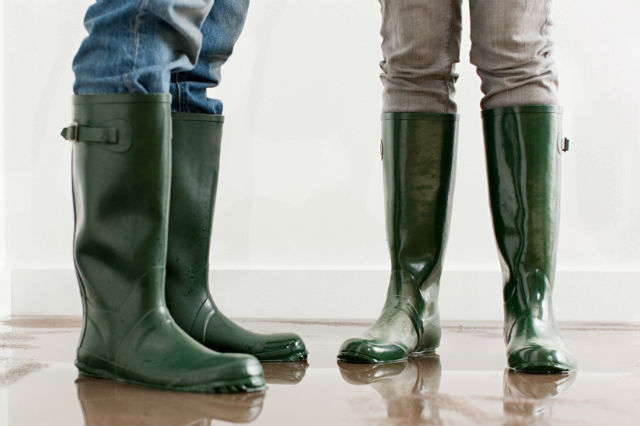Though some areas are more susceptible than others, heavy rains and flash floods should be a concern for those living in the Northeast. After all, we are on the coast and so many of us live near water. Are your home and belongings protected with flood insurance?
Brush up on your knowledge of flood insurance with the answers to these frequently asked questions.
Do I need flood insurance if I have homeowners or renters insurance?
Short answer: Yes. Homeowners insurance does not cover flood damage.
Longer answer: In the 1960s, after a series of flooding along the Mississippi River, flooding was viewed as an uninsurable risk, and many private homeowners insurance companies pulled out of offering coverage for flood damage. Thus, the National Flood Insurance Program was born. The program provides federally backed flood insurance to certain communities participating in the program. If your community doesn’t participate in the program, you can’t buy a policy through the NFIP, but you may be able to buy a policy through a private insurance company.
Check the NFIP Community Book to see if your town or city participates in the program.
Do I need flood insurance if I don’t live near water?
If you don’t live in a Special Flood Hazard Area, defined by FEMA has having a 1% or greater chance or flooding in any given year, you’re not federally required to have flood insurance. However, your mortgage lender may still require you to have it. And, according to the Federal Emergency Management Agency, more than 40% of flood claims come from properties outside high-risk flood zones. So, though you may not technically need to have flood insurance, it’s still recommended as floods can happen anywhere.
What exactly does flood insurance cover?
In general, flood insurance protects your home from damage done by rising waters, inundation (what happens when water covers normally dry land) and mudflows (when floodwater mixes with mud). It covers the cleanup, debris removal and repairs necessary after a flood.
You can insure your house for up to $250,000 with building property coverage and your belongings for up to $100,000 with personal property coverage, which must be purchased separately through the National Flood Insurance Program. You may be able to purchase additional coverage through a private flood insurance program.

What doesn’t flood insurance cover?
Knowing what isn’t covered is as important to understanding flood insurance as knowing what is covered.
Flood insurance doesn’t cover damage that affects property and belongings outside the home, including trees, walkways, pools, decks and patios, fences, septic systems and the like. In furnished areas below ground level, insurance coverage doesn’t include paneling, bookcases, window treatments, carpeting and other floor coverings, drywall for walls and ceilings, and personal property such as clothing, electronic equipment, kitchen supplies and furniture.
Coverage for basement and crawlspace damage is pretty limited.
Policyholders should also be aware of the “earth movement” or “long-term differential movement” clause. Loss of property caused by earth movement, even if due to a flood, isn’t covered. That means your policy may exclude damage caused by landslides, sinkholes or movement of land due to water accumulation or gradual erosion.
What should I do before a flood?
If you have flood insurance, take pictures or video of your property to document the condition of your home before any damage is done. Photograph the house, the foundation, the interior and exterior walls and each room inside to avoid a dispute over whether the damage was pre-existing. FEMA recommends that you keep a file of these photos along with a copy of your insurance policies, plus serial numbers and receipts for major appliances and electronics.
If you don’t have flood insurance, first ensure that your community participates in the NFIP, then talk to an insurance agent about your options. Keep in mind that there is a 30-day waiting period to purchase flood insurance, so you can’t wait until just before a storm (home closings where it is required by the lender are an exception.)
Contact an experienced AAA Insurance agent today.
What should I do after a flood?
First, call your insurance agent or insurance company. Make a list of damaged or lost items and include receipts if possible. Take pictures of the damage after the flood, before any cleanup or debris removal.
Learn more about what to do before, during and after a flood.
Do you have flood insurance that has come in handy? Tell us how it has helped you in the comments below.
This article has been updated and republished from a previous version.
5 Thoughts on “Flood Insurance FAQ: What You Need to Know”
Leave A Comment
Comments are subject to moderation and may or may not be published at the editor’s discretion. Only comments that are relevant to the article and add value to the Your AAA community will be considered. Comments may be edited for clarity and length.















How much is the flood insurance for zip 77089
Hello Elizabeth. Please reach out to your local club at AAA Auto Club Enterprise at http://www.ace.aaa.com or 1-888-897-4898. They would be able to provide a quote. Thank you!
Why have flood insurance when it does not cover basements. Everyone has a basement in New England, and most are finished living space.
I have never been clear on what insurance covers rising ground water like we had in 2010 here in Boston
Hi there!
You might want to visit AAA.com/Insurance and one of our helpful AAA Insurance agents can tell you more about what insurance might cover during such an event.
Thanks for reading!
-Dana